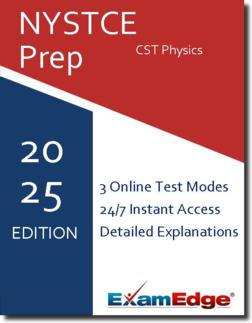NYSTCE CST Physics (163) Practice Tests & Test Prep by Exam Edge - Topics
Based on 40 Reviews
- Real Exam Simulation: Timed questions and matching content build comfort for your NYSTCE CST Physics test day.
- Instant, 24/7 Access: Web-based NYSTCE CST Physics practice exams with no software needed.
- Clear Explanations: Step-by-step answers and explanations for your NYSTCE exam to strengthen understanding.
- Boosted Confidence: Reduces anxiety and improves test-taking skills to ace your NYSTCE CST Physics (163).

Understanding the exact breakdown of the NYSTCE CST Physics test will help you know what to expect and how to most effectively prepare. The NYSTCE CST Physics has 90 multiple-choice questions and 1 essay questions. The exam will be broken down into the sections below:
| NYSTCE CST Physics Exam Blueprint | ||
|---|---|---|
| Domain Name | % | Number of Questions |
| Forces and Motion | 16% | 14 |
| Conservation of Energy and Energy Transfer | 16% | 14 |
| Electricity and Magnetism | 15% | 14 |
| Mechanical Wave Properties | 11% | 10 |
| Optics and Electromagnetic Waves | 11% | 10 |
| Modern Physics | 11% | 10 |
| Pedagogical Content Knowledge (Constructed-Response) - Not Included | 20% | 18 |


